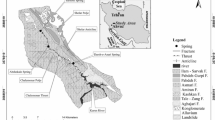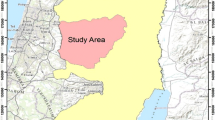Abstract
Groundwater vulnerability maps were constructed for the surface water catchment area of Tanour and Rasoun spring (north-west of Jordan) using the COP and EPIK intrinsic groundwater vulnerability assessment methods. Tanour and Rasoun springs are the main water resources for domestic purposes within the study area. A detailed geological survey was carried out, and data of lithology, karst features, precipitation, vegetation and soil cover, etc. were gathered from various sources for the catchment area in order to determine the required parameters for each method. ArcGIS software was used for map preparation. In the resulting COP vulnerability map, spatial distribution of groundwater vulnerability is as follows: (1) high (37%), (2) moderate (34.8%), (3) low (20.1%), and (4) very low (8.1%). In the EPIK vulnerability map, only two out of four vulnerability classes characterize the catchment area: very high vulnerable areas (38.4%) and moderately vulnerable areas (61.6%). Due to limited soil thickness, the low vulnerability class is absent within the catchment. The high percentage of very high to moderately vulnerable areas displayed by both the COP and EPIK vulnerability assessment methods are reflected by different pollution events in Tanour and Rasoun karst springs especially during the winter season. The high sensitivity of the aquifer to pollution can be explained by different factors such as: thin or absent soil cover, the high development of the epikarst and karst network, and the lithology and confining conditions of the aquifer.









Similar content being viewed by others
References
Abdelhamid G (1993) Geological map of JARASH [map]. Ministry of Energy and Mineral Resources—Natural Resources Authority (geology directorate). National mapping project, sheet No. (3154-I). 1 sheet: 1:50.000
Abdelhamid G (1995) The geology of Jarash area—map sheet (3154-I), Bulletin 30. Ministry of Energy and Mineral Resources—Natural Resources Authority (geology directorate), Jordan
Daly D, Dassargues A, Drew D, Dunne S, Goldscheider N, Neale S, Popescu IC, Zwahlen F (2002) Main concepts of the “European approach” to karst-groundwater-vulnerability assessment and mapping. Hydrogeol J 10:340–345. doi:10.1007/s10040-001-0185-1
Doerfliger N, Zwahlen F (1998) Practical guide-groundwater vulnerability mapping in karstic region (EPIK)-application to groundwater protection zone. Swiss Agency for the Environment, Forests and landscape (SAEFL), Bern
Doerfliger N, Jeannin P-Y, Zwahlen F (1999) Water vulnerability assessment in karst environments: a new method of defining protection areas using a multi-attribute approach and GIS tools (EPIK method). Environ Geol J 39(2):165–176
Foster S, Hirata R (1988) Groundwater pollution risk assessment—a methodology using available data. Pan American Center for Sanitary Engineering and Environmental Sciences (CEPIS), Peru
Gogu RC, Dassargues A (2000) Sensitivity analysis for the EPIK method of vulnerability assessment in a small karstic aquifer, Southern Belgium. Hydrogeol J 8:337–345
Goldscheider N (2002) Hydrogeology and vulnerability of karst systems—examples from the northern Alps and the Swabian Alb. Dissertation, University of Karlsruhe
Goldscheider N (2003) The concept of groundwater vulnerability. In: Zwahlen F (ed) COST action 620-vulnerability and risk mapping for the protection of carbonate (karst) aquifers. Final report, pp 5–9
Goldscheider N, Klute M, Sturm S, Hötzl H (2000) The PI method—a GIS-based approach to mapping groundwater vulnerability with special consideration of karst aquifers. Z Angew Geol 46(3):157–166
Hamdan I (2016) Characterization of groundwater flow and vulnerability assessment of karstic aquifers—development of a travel time based approach and application to the Tanour and Rasoun spring catchment (Ajloun, NW-Jordan). Dissertation, University of Göttingen
Hamdan I, Wiegand B, Toll M, Sauter M (2016) Spring response to precipitation events using δ18O and δ2H in the Tanour catchment, NW Jordan. Isot Environ Health Stud 52(6):682–693. doi:10.1080/10256016.2016.1159205
Hobler M, Margane A, Almomani M, Subah A (2001) Groundwater Resources of northern Jordan. Vol. 4 Contributions to the hydrogeology of northern Jordan. Federal Institute for Geosciences and Natural Resources (BGR) and Ministry of Water and Irrigation (MWI), Jordan
Jeannin PY, Cornaton F, Zwahlen F, Perrochet P (2001) VULK: a tool for intrinsic vulnerability assessment and validation. In: 7th conference on limestone hydrology and fissured media, Besanc on 20–22 September 2001. Sci Tech Environm Mém 13:185–188 (cited in Vias et al. 2006)
JMD (Jordan Meteorological Department) (2014) Daily minimum and maximum temperature data for Ras Munif station (AH0003) for the time period between 1980 and 2013 (soft copy). Amman, Jordan
Klimchouk A (1997) The natural and principal characteristics of epikarst. In: Proceedings of the 12th International Congress of Speleology La Chaux-de-Fonds, Switzerlands, 10-17.8.1997, Vol. 1 (cited in Golscheider 2000)
Margat J (1968) Vulnérabilité des nappes d’eau souterraine à la pollution. BRGM-publication 68 SGL 198 HYD; Orléans (cited in Goldscheider, 2003)
MoA (Ministry of Agriculture) (1994) National Soil Map and Land Use Project. The soil of Jordan, level 2: semi detailed studies. Volume 2: main report, hunting technical services in association with Soil Survey and Land Research Centre, Jordan
MWI (Ministry of Water and Irrigation) (2013a) Jordan water sector facts and figures 2013. 1st edn, Jordan
MWI (Ministry of Water and Irrigation) (2013b) Daily minimum and maximum temperature data for Ras Munif station (AH0003) for the time period between 1969 and 1979 (soft copy). Amman, Jordan
MWI (Ministry of Water and Irrigation) (2014a) Daily rainfall data for Ras Munif station (AH0003) for the time period between 1968/1969 and 2013/2014 (soft copy). Amman, Jordan
MWI (Ministry of Water and Irrigation) (2014b) Wells lithology and pumping test data (soft copy). Amman, Jordan
MWI (Ministry of Water and Irrigation) (2015a) Monthly averages springs discharge for Tanour, Rasoun and Beida Springs for the time period between 1963 and 2014 (soft copy). Amman, Jordan
MWI (Ministry of Water and Irrigation) (2015b) Monthly production values for Tanour and Rasoun Springs for the time period between 1996 and 2014 (soft copy). Amman, Jordan
MWI (Ministry of Water and Irrigation) (2016) Groundwater policy. http://www.mwi.gov.jo/sites/en-us/SitePages/Water%20Policies/Ground%20Water%20Policy.aspx. Accessed Mar 2016
Pronk M, Goldscheider N, Zopfi J, Zwahlen F (2009) Percolation and particle transport in the unsaturated zone of a karst aquifer. Ground Water 47(3):361–369. doi:10.1111/j.1745-6584.2008.00509.x
Sililo OTN, Saayman IC, Fey MV (2001) Groundwater vulnerability to pollution in urban catchments. Report to the Water Research Commission, WRC Project No. 1008/1/01. Water research commission, ISBN 1868457834. University of Cape Town, Pretoria
UNDP (United Nations Development Programme) (2015) Overview about Jordan. http://www.jo.undp.org/content/jordan/en/home/countryinfo/. Accessed Mar 2015
USGS earth explorer (2014a) ASTER digital elevation model 30 m resolution. http://earthexplorer.usgs.gov. Accessed June 2014
Vias JM, Andreo B, Perles MJ, Carrasco F, Vadillo I, Jiménez P (2002) Preliminary proposal of a method for vulnerability mapping in carbonate aquifers. In: Carrasco F, Durán JJ, Andreo B (ed) Karst and environment, pp 75–83 (cited in Vias et. al. 2003)
Vias JM, Andreo B, Perles MJ, Carrasco F, Vadillo I, Jiménez P (2003) The COP method. In: Zwahlen F (ed) COST action 620-vulnerability and risk mapping for the protection of carbonate (karst) aquifers. Final report, pp 163–171
Vias JM, Andreo B, Perles M, Carrasco F, Vadillo I, Jiménez P (2006) Proposed method for groundwater vulnerability mapping in carbonate (karstic) aquifers: the COP method-application in two pilot sites in southern Spain. Hydrogeol J 14(6):912–925. doi:10.1007/s10040-006-0023-6
Vrba J, Zoporozec A (eds) (1994) Guidebook on mapping groundwater vulnerability, 16th edn. International Contributions to Hydrogeology (IAH), Hannover
Acknowledgments
The doctoral position of Ibraheem Hamdan was funded by the Federal Ministry of Education and Research (BMBF) via the German Academic Exchange Service (DAAD) special programme (NaWaM), and study scholarships and research Grants 14 (56322373).
Author information
Authors and Affiliations
Corresponding author
Rights and permissions
About this article
Cite this article
Hamdan, I., Margane, A., Ptak, T. et al. Groundwater vulnerability assessment for the karst aquifer of Tanour and Rasoun springs catchment area (NW-Jordan) using COP and EPIK intrinsic methods. Environ Earth Sci 75, 1474 (2016). https://doi.org/10.1007/s12665-016-6281-2
Received:
Accepted:
Published:
DOI: https://doi.org/10.1007/s12665-016-6281-2




